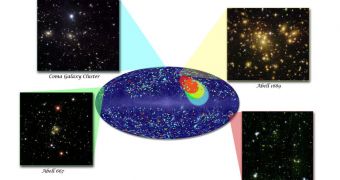Astrophysicists are currently investigating a phenomenon called “dark flow,” which may be pulling on matter at the edge of the Universe in a way that cannot be explained by current data. The concept was developed when researchers observed motions in the large structure of the Cosmos that shouldn't have existed.
It should be mentioned from the start that the debate about the very existence of the dark flow has yet to be settled. The international astronomical community is as divided on this issue as possible.
What this concept implies is that there is a structure beyond the visible Universe that is pulling on matter around us in peculiar ways, that cannot be accounted for by event happening in the Cosmos.
When the idea was first proposed, many thought of the Middle Age maps depicting sea dragons at the edges of the world, and not many were pleased to consider the possibility that this may actually be taking place with the Universe.
One of the reasons why dark flow was proposed was because in-depth observations of the areas at the very edge of the known Cosmos have revealed the existence of strange motions, involving huge numbers of galactic clusters.
All of these massive structures appear to be heading towards a single spot, and thus far astronomers have been at a loss in explaining why that is, Daily Galaxy reports.
Making matters even worse is the fact that this motion shows a preference for a single direction. This is out of tune with the ultimate reference frame, the Cosmic Microwave Background (CMB).
The CMB is made up of residual light that permeates the Universe. The light was emitted some 380.000 years after the Big Bang exploded everything into existence. Reported to the Background, no motion should exhibit preferences for a particular direction.
NASA Goddard Space Flight Center (GSFC) expert Alexander Kashlinsky demonstrates in a new study that the dark flow can be tracked up to twice the distance it was originally thought to span.
“This is not something we set out to find, but we cannot make it go away. Now we see that it persists to much greater distances - as far as 2.5 billion light-years away,” the expert explains.
All of the clusters are moving along an imaginary line extending from our solar system into the direction of the constellations Centaurus and Hydra. What experts could not establish with certainty is whether the clusters are moving towards or away from Earth.
“We detect motion along this axis, but right now our data cannot state as strongly as we'd like whether the clusters are coming or going,” Kashlinsky says.
What puzzles experts even further is the fact that the clusters keep a constant, 800-kilometer-per-hour speed, which means that the flow cannot be the results of a supermassive black hole's gravitational pull.
Refining the speed, axis, and direction of this peculiar motion is now the main objective of many science teams. The main way of doing this is by improving models of how hot gas behaves inside galaxies.
In the near future, the data obtained from these models will be cross-referenced with readings of the CMB obtained by the WMAP project and the European Space Agency's (ESA) Planck telescope.

 14 DAY TRIAL //
14 DAY TRIAL //